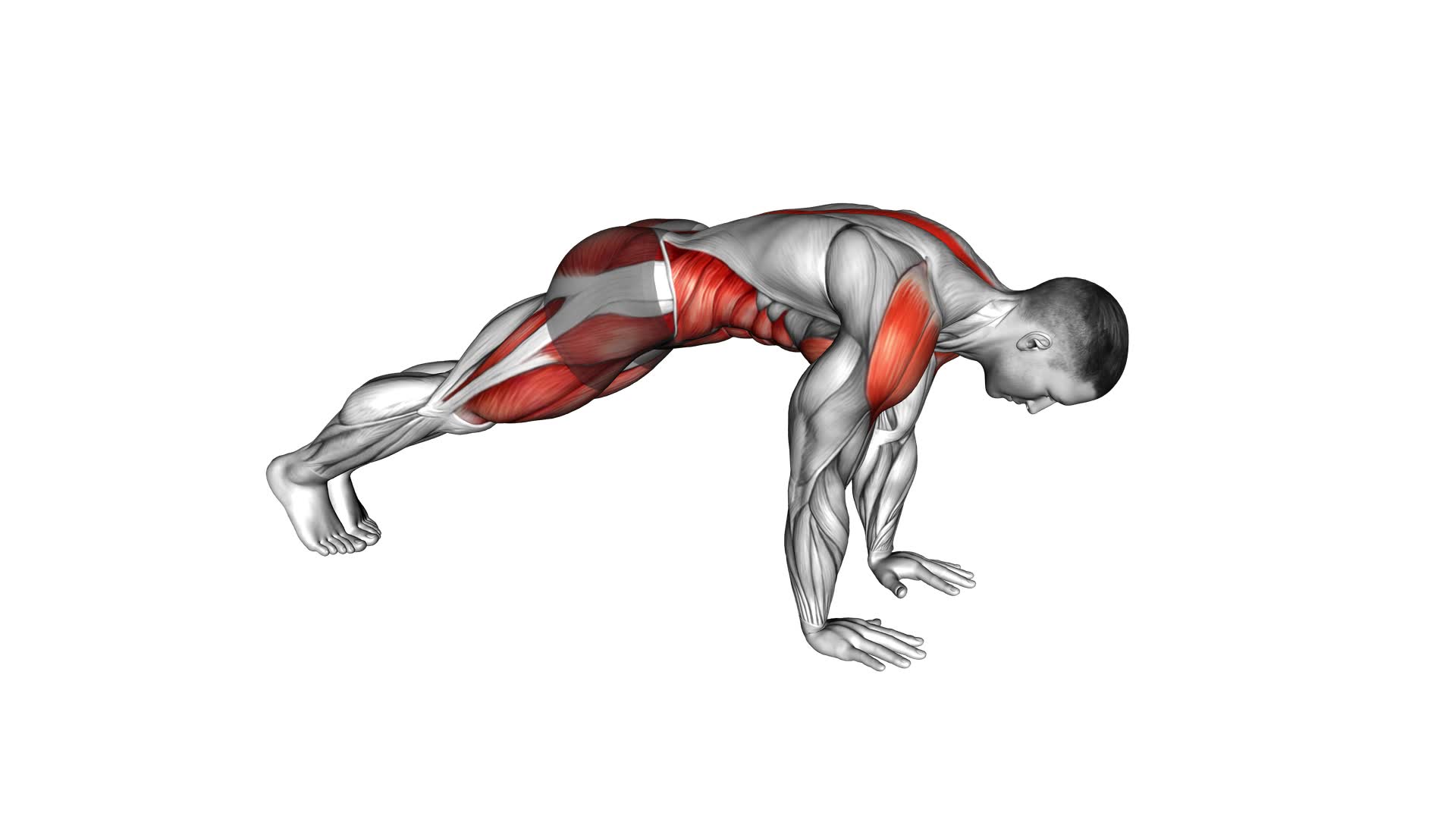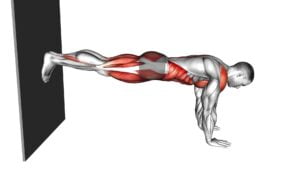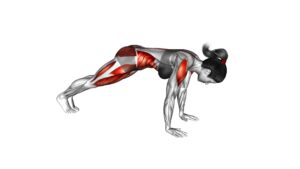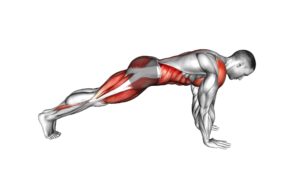Side Mountain Climber (male) – Video Exercise Guide & Tips

Are you ready to take your workout to new heights?
Watch This Exercise Video
In this video exercise guide, we'll show you how to master the side mountain climber.
This challenging move targets your core, arms, and legs, giving you a full-body workout.
With our step-by-step instructions and helpful tips, you'll be able to perform this exercise with proper form and technique.
Get ready to push yourself and reach new fitness goals with the side mountain climber.
Let's get started!
Key Takeaways
- Side Mountain Climber targets multiple muscle groups, including the core, shoulders, and legs
- Proper form and technique involve starting in a plank position, engaging the core, and avoiding jerky movements
- Variations and modifications include the Cross Body Mountain Climber, Elevated Mountain Climber, and adding a knee tuck at the top of the movement
- Common mistakes to avoid include failing to engage core muscles, improper hand placement, and rotating hips during the movement
Benefits of the Side Mountain Climber
To maximize the effectiveness of your workout, incorporating the Side Mountain Climber can offer a range of benefits. This exercise targets multiple muscle groups, including the core, shoulders, and legs, making it a great full-body workout option.
One of the key benefits of the Side Mountain Climber is its ability to improve core strength and stability. As you bring your knees towards your chest in a controlled manner, your core muscles engage to maintain balance, helping to strengthen and tone your abs and obliques.
Additionally, the Side Mountain Climber can also enhance shoulder and arm strength. By supporting your body weight on your hands, you engage the muscles in your shoulders, chest, and triceps, helping to build upper body strength.
To modify the Side Mountain Climber, you can start by performing the exercise at a slower pace or reducing the range of motion. This allows you to gradually increase the difficulty level as you build strength and endurance.
It's important to maintain proper form throughout the exercise to prevent injury. Keep your wrists aligned with your shoulders and your core engaged to protect your lower back. Avoid letting your hips sag or lift too high, as this can strain the muscles and put unnecessary stress on your joints.
Proper Form and Technique for the Side Mountain Climber
To perform the Side Mountain Climber exercise with proper form and technique, start by getting into a high plank position. Here's how to do it correctly:
- Begin in a plank position with your hands directly under your shoulders and your body in a straight line from head to heels.
- Engage your core and lift your right foot off the ground, bringing your right knee towards your right elbow.
- Return your right foot to the starting position and repeat the movement on the left side, bringing your left knee towards your left elbow.
Proper form is crucial to maximize the benefits and minimize the risk of injury. Keep the following tips in mind:
- Maintain a stable plank position throughout the exercise, avoiding any sagging or arching of your back.
- Keep your shoulders down and away from your ears, and your neck in a neutral position.
- Move with control and avoid any jerky or fast movements.
If you're a beginner or looking for alternative exercises, you can modify the side mountain climber by performing a knee-to-elbow plank or a standing knee-to-elbow crunch. These variations will still target your core muscles while providing a lower impact option.
Now that you know the proper form and technique for the side mountain climber, let's explore some variations and modifications to make this exercise more challenging or accessible for different fitness levels.
Variations and Modifications for the Side Mountain Climber
Now let's explore some ways to modify and challenge the Side Mountain Climber exercise. There are several variations and modifications you can incorporate to target different muscle groups and intensify your workout.
One variation you can try is the Cross Body Mountain Climber. Instead of bringing your knee towards your opposite elbow, bring it towards the same side elbow. This variation places more emphasis on your obliques and challenges your core stability.
Another modification is the Elevated Mountain Climber. Place your hands on an elevated surface, such as a bench or step, and perform the exercise. This modification increases the range of motion and engages your upper body muscles, including your shoulders and chest.
To further challenge yourself, you can add a knee tuck at the top of the movement. As you bring your knee towards your chest, lift your hips and tuck your knee in towards your torso. This modification increases the intensity and engages your abdominal muscles even more.
Lastly, you can incorporate a resistance band into the Side Mountain Climber. Place the band around your ankles or knees and perform the exercise as usual. The added resistance challenges your lower body muscles, particularly your glutes and thighs.
Common Mistakes to Avoid During the Side Mountain Climber
When performing the Side Mountain Climber, it's important to be mindful of common mistakes that can hinder your progress.
First, make sure to engage your core muscles throughout the exercise to maintain stability and control.
Secondly, ensure proper hand placement by keeping your wrists aligned with your shoulders to prevent strain.
Lastly, avoid rotating your hips during the movement, as this can lead to improper form and potential injury.
Engaging Core Muscles
Engage your core muscles properly to maximize the effectiveness of the Side Mountain Climber exercise. Proper core engagement is crucial for maintaining stability and activating the oblique muscles. Here are three key tips to help you engage your core muscles correctly during the Side Mountain Climber:
- Start by assuming a plank position with your hands directly under your shoulders and your body in a straight line. This position will activate your core and ensure proper alignment.
- As you bring your knee towards your elbow during the exercise, focus on contracting your abdominal muscles and squeezing your obliques. This will intensify the core engagement and target the side muscles effectively.
- Avoid sagging or rounding your lower back during the movement. Keep your core tight and your hips level to maintain stability and prevent any strain on your lower back.
Proper Hand Placement
To ensure proper hand placement during the Side Mountain Climber exercise, align your hands directly under your shoulders for optimal stability and control. This hand position is crucial in maintaining proper form and preventing unnecessary strain or injury.
When your hands are aligned with your shoulders, it allows for a more stable base and evenly distributes your weight. Additionally, pay attention to your wrist alignment. Your wrists should be in a neutral position, neither flexed nor extended, to avoid putting unnecessary pressure on them.
Keeping your hands and wrists in the correct position won't only improve your performance during the Side Mountain Climber exercise but also help prevent any discomfort or pain that may arise from improper form.
Avoiding Hip Rotation
Maintain proper form and prevent hip rotation by keeping your core engaged throughout the Side Mountain Climber exercise. This is crucial for preventing injuries and increasing stability.
Here are three important tips to help you avoid hip rotation and get the most out of your workout:
- Focus on your core: Engage your abdominal muscles by pulling your belly button towards your spine. This will help stabilize your body and prevent your hips from rotating.
- Keep your shoulders square: Ensure that your shoulders are aligned with your hands and wrists. This will help maintain proper form and prevent any twisting or rotation in your hips.
- Control your movements: Avoid swinging your hips or rushing through the exercise. Take your time and focus on controlled and deliberate movements to maintain stability and prevent any unwanted rotation.
By following these tips, you can effectively avoid hip rotation and maximize the benefits of the Side Mountain Climber exercise.
Now, let's move on to the next section for some tips on how to incorporate this exercise into your workout routine.
Tips for Incorporating the Side Mountain Climber Into Your Workout Routine
Include the Side Mountain Climber exercise in your workout routine to add intensity and target your core and upper body muscles. To perform this exercise effectively, it's important to focus on your breathing technique. Take a deep breath in as you bring your knee towards your chest, and exhale as you extend your leg back. This will help you maintain proper form and engage your core muscles more effectively.
When incorporating the Side Mountain Climber into your routine, it's recommended to start with 2-3 sets of 10-12 reps on each side. This will allow you to build strength and endurance gradually. As you become more comfortable with the exercise, you can increase the number of sets or reps to continue challenging your muscles.
To maximize the benefits of the Side Mountain Climber, it's important to maintain proper form throughout the exercise. Keep your core engaged, shoulders aligned with your wrists, and hips level. Avoid any twisting or rotating of your hips, as this can put strain on your lower back. Focus on smooth and controlled movements to ensure you're targeting the intended muscles effectively.
Incorporating the Side Mountain Climber into your workout routine can be a great way to enhance your core and upper body strength. Remember to focus on your breathing technique, follow the recommended sets and reps, and maintain proper form for optimal results.
Safety Precautions for Performing the Side Mountain Climber
For performing the Side Mountain Climber exercise safely, it's important to pay attention to proper form and technique. Here are three safety precautions to keep in mind to prevent injuries while performing this exercise:
- Warm up: Before starting the Side Mountain Climber, make sure to warm up your muscles with some light cardio exercises or dynamic stretches. This helps increase blood flow, flexibility, and prepares your body for the workout.
- Maintain proper alignment: When performing the Side Mountain Climber, keep your body in a straight line from head to toe. Avoid arching your back or letting your hips sag. Engage your core muscles and focus on stabilizing your body throughout the movement.
- Start slow and progress gradually: If you're new to the Side Mountain Climber, start with a modified version or perform the exercise at a slower pace. As you become more comfortable and confident, you can gradually increase the intensity and speed. This gradual progression helps reduce the risk of strain or overexertion.
Frequently Asked Questions
How Many Calories Does the Side Mountain Climber Exercise Burn?
The side mountain climber exercise is a great way to burn calories and aid in weight loss. By incorporating this exercise into your routine, you can increase your calorie burn and contribute to your overall fitness goals.
This exercise targets multiple muscle groups and requires a combination of strength and cardio. So, if you're looking to maximize your calorie burn and shed some pounds, the side mountain climber is definitely worth considering.
Can the Side Mountain Climber Help With Weight Loss?
The side mountain climber exercise can definitely help with weight loss. It's known for its effectiveness in burning fat and can be a great addition to your fitness routine.
By engaging multiple muscle groups and increasing your heart rate, this exercise promotes calorie burn and boosts metabolism.
Incorporating side mountain climbers into your workouts regularly can contribute to your weight loss goals and overall fitness journey.
How Often Should the Side Mountain Climber Be Included in a Workout Routine?
Including the side mountain climber in your workout routine can have numerous benefits. It's a great exercise for improving core strength, stability, and overall cardiovascular fitness.
Incorporating it into a high-intensity interval training (HIIT) workout can help boost calorie burn and aid in weight loss.
For those at an advanced fitness level, there are variations of the side mountain climber that can provide an even greater challenge and further enhance your workout.
Can the Side Mountain Climber Be Modified for Beginners or Individuals With Limited Mobility?
The Side Mountain Climber can definitely be modified for beginners or individuals with limited mobility.
There are several modified variations that can make this exercise more accessible, such as doing the movement with your hands on an elevated surface or performing the exercise at a slower pace.
These modifications allow you to still benefit from the core and upper body strengthening aspects of the exercise, making it suitable for seniors or those with limited mobility.
Are There Any Specific Muscle Groups That the Side Mountain Climber Targets?
The side mountain climber targets several specific muscle groups, providing excellent muscle activation. It primarily works your core muscles, including the rectus abdominis, obliques, and transverse abdominis. Additionally, it engages your hip flexors, glutes, and quadriceps.
Conclusion
In conclusion, the Side Mountain Climber is a highly effective exercise that targets multiple muscle groups, improves cardiovascular endurance, and enhances overall body strength.
By maintaining proper form and technique, avoiding common mistakes, and incorporating variations and modifications, you can maximize the benefits of this exercise.
Remember to prioritize safety by starting with proper warm-up and gradually increasing intensity.
So, add the Side Mountain Climber to your workout routine and enjoy the incredible results it can offer.

Author
Years ago, the spark of my life’s passion ignited in my mind the moment I stepped into the local gym for the first time. The inaugural bead of perspiration, the initial endeavor, the very first surge of endorphins, and a sense of pride that washed over me post-workout marked the beginning of my deep-seated interest in strength sports, fitness, and sports nutrition. This very curiosity blossomed rapidly into a profound fascination, propelling me to earn a Master’s degree in Physical Education from the Academy of Physical Education in Krakow, followed by a Sports Manager diploma from the Jagiellonian University. My journey of growth led me to gain more specialized qualifications, such as being a certified personal trainer with a focus on sports dietetics, a lifeguard, and an instructor for wellness and corrective gymnastics. Theoretical knowledge paired seamlessly with practical experience, reinforcing my belief that the transformation of individuals under my guidance was also a reflection of my personal growth. This belief holds true even today. Each day, I strive to push the boundaries and explore new realms. These realms gently elevate me to greater heights. The unique combination of passion for my field and the continuous quest for growth fuels my drive to break new ground.







